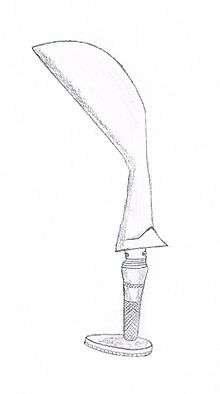Ayudha katti
| Ayudha katti | |
|---|---|
| Type | Broad blade |
| Place of origin | Kodagu ,North Malabar |
| Service history | |
| Used by | Kodava people, Thiyyas |
| Wars | Yes |
| Specifications | |
| Weight | 2.5 pounds (1.1 kg) |
| Length | 50 centimetres (20 in) |
| Width | 9 centimetres (3.5 in) |
|
| |
| Blade type | Single edge |
| Hilt type | wood, horn |
| Scabbard/sheath | wood, silver |
| Head type | steel |
Ayudha katti (also written ayda katti or aydha katti) is an indigenous weapon of war and tools to the Kodava people of Kodagu, in the state of Karnataka, India and of Thiyyas of North Malabar. The ayudha katti is developed from an implement used to cut through dense undergrowth. Unlike most blades, the ayudha katti is worn without a sheath.
Origin
The ayudha katti is the traditional sword of the Kodavas and Thiyyas of North Malabar the Thiyyas call it Kanna katti and it was very ritual and sacred for them. [1] The Kodavas inhabit the region of Kodagu in southwestern India in what is now the state of Karnataka. The Kodavas have resided in the area for over 2 millennia cultivating paddy fields, maintaining cattle herds and carrying arms during war.[2] The invention of the ayudha katti probably started around the 17th-century. It was first invented as an implement used to cut through dense undergrowth.[3] The shape of the blade is similar with the Turkish yatagan and northern Indian sosun pattah, which indicates that it is related to the Ancient Greek kopis blade.[3]
During the colonial period, the British named the region "Coorgi", a corruption of the Kannada word "kodaga" or "kodagu" meaning "hilly, steep". The word refers to the geographical condition of the region.[4]
The Kodavas were known as tough warriors, establishing many wars against the neighboring nations to protect the sovereignty of their land. When the British Empire intervened the region in 1834, a war broke up between the Kodavas and the British. In 1884, a riot broke out near Malappuram. As a result of this incident, the British punished the Kodavas by seizing their weapons, including the pichangatti. It was recorded that "17,295 weapons of which 7,503 were guns" were confiscated by the British colonial administration. Most of these seized weapons were dumped into the sea, while the high-quality examples can still be seen in what is now the Madras Museum.[5][6]
Description

The length of the ayudha katti varies greatly. Some ayudha katti can reach up to 50 centimetres (20 in) long. There are two known forms of the ayudha katti. The 'war' form is mainly used for melee combat, and the 'prestige' form is worn for daily use. Unlike the prestige form, the war ayudha katti lacks the egg-shaped pommel plate on the base of the hilt. The ayudha katti is one of the rarest of the edged- weapons.[5]
The blade of the ayudha katti measures about 38 centimetres (15 in) long. The sharpened edge is located on the concave side of the blade. The top (the non-sharpened edge) of the sword is initially concave, then it tapers slightly for about a quarter of the length until it becomes extremely convex, and then it tapers quickly until the point. The widest part of the blade reaches 9 centimetres (3.5 in) wide. The overall shape of ayudha katti is short and quite heavy. The shape somehow resembles the moplah sword used by the Muslim population on the Malabar Coast, although unlike the moplah, the ayudha katti is sharpened only on one side and has no medial ridge.[7] Ayudha katti is mostly a chopping tool, a very common weapon found worldwide. It was used for clearing the forest, as an agricultural tool, as well as melee weapon in war.[5]
The hilt of the ayudha katti can be made of wood or horn (usually of the water buffalo). The pommel is a plate with the shape if an egg and is made of same material as the hilt. The hilt is often decorated with traditional geometric or floral carvings.[3]
Ayudha katti is peculiarly worn without a scabbard. It is typically held in the hand while sitting. Prestige form ayudha katti has a special carrying device consisting of a silver chain that serves as a belt and a large brass ring for hanging the knife in the back of the blade's holder.[5]
See also
| Wikimedia Commons has media related to Ayudha katti. |
- Moplah (similar, but with different hilt shape)
- Golok
- Pichangatti
References
- ↑ Stone 2013, p. 84.
- ↑ "Coorg (district, India)". Britannica Online Encyclopedia. Retrieved 2012-06-01.
- 1 2 3 Gahir & Spencer 2006, p. 129.
- ↑ Ganapathy 1967, p. 28.
- 1 2 3 4 Atkinson 2016.
- ↑ Thurston 1909.
- ↑ Stone 2013, p. 456.
Cited works
- Atkinson, David J. (2016). "War Ayda Katti". Atkinson Swords. Atkinson Swords. Retrieved November 18, 2017.
- Gahir, Sunita; Spencer, Sharon, eds. (2006). Weapon - A Visual History of Arms and Armor. New York City: DK Publishing. ISBN 9780756622107.
- Ganapathy, B. D. (1967). Kodavas (Coorgs), their customs and culture. copies available at Kodagu. Retrieved 23 August 2011. </ref>
- Stone, George Cameron (2013). A Glossary of the Construction, Decoration and Use of Arms and Armor: in All Countries and in All Times. Dover: Courier Corporation. ISBN 9780486131290.
- Thurston, Edgar (1909). Castes and Tribes of Southern India, Volume IV of VII. Library of Alexandria. ISBN 9781465582393.